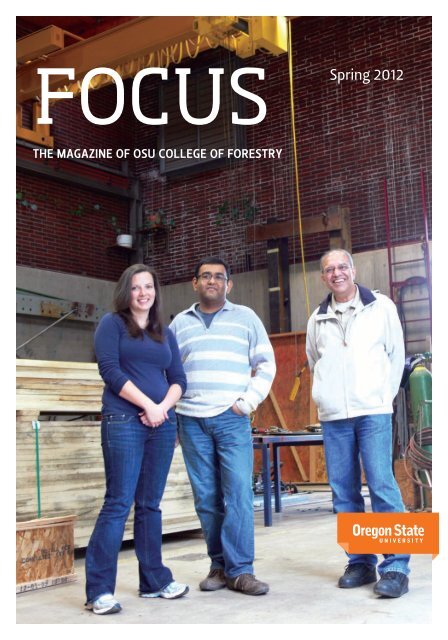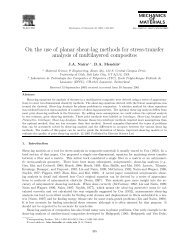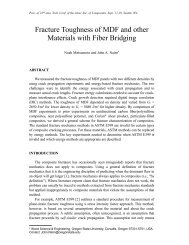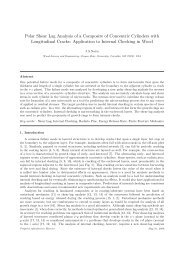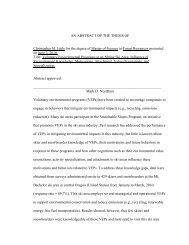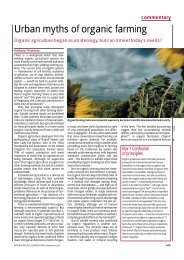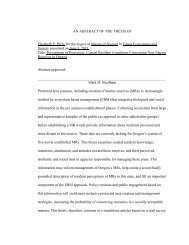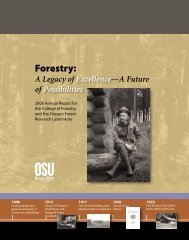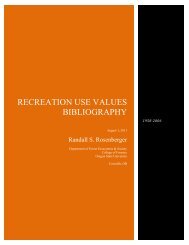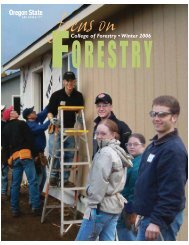Spring 2012 - College of Forestry - Oregon State University
Spring 2012 - College of Forestry - Oregon State University
Spring 2012 - College of Forestry - Oregon State University
Create successful ePaper yourself
Turn your PDF publications into a flip-book with our unique Google optimized e-Paper software.
FOCUS<br />
<strong>Spring</strong> <strong>2012</strong><br />
THE MAGAZINE OF OSU COLLEGE OF FORESTRY
Dean’s Column<br />
We recently held our annual Dean’s Award and Retiree<br />
Celebration. This event is a powerful reminder <strong>of</strong> the experience,<br />
expertise, and commitment our employees provide to the <strong>College</strong><br />
and the <strong>University</strong>. The awards recognize exemplary performance<br />
in fostering student success, research, extended education, service,<br />
and general support by all levels <strong>of</strong> employees. Nominations are<br />
submitted by other employees, and I make the final selections. The<br />
breadth <strong>of</strong> efforts being written about is insightful, and the fact that<br />
co-workers are taking valuable time to write nominations speaks<br />
volumes about the collaboration and recognition <strong>of</strong> effort between<br />
employees with different duties and roles.<br />
Ten <strong>of</strong> our valued colleagues retired in 2011—they had 247 years <strong>of</strong> service to OSU between<br />
them. That is commitment! The <strong>College</strong> is losing day-to-day contact with some wonderful<br />
researchers, educators, leaders, support staff, and friends. Their efforts and impact will be<br />
remembered.<br />
<strong>Spring</strong> is providing a new sense <strong>of</strong> growth to the <strong>College</strong>. After years <strong>of</strong> faculty attrition, I am<br />
excited to see a series <strong>of</strong> searches completed or nearing an end. I expect a number <strong>of</strong> new faces<br />
to arrive in Corvallis this summer. Laurence Schimleck (Georgia) is our new department head<br />
in Wood Science & Engineering. Christopher Still (UCSB), Thomas Hilker (Colorado), and Michael<br />
Wing (OSU) will add depth for instruction and research. Outstanding finalists for the Spaniol Chair<br />
have visited campus. New searches have started for a natural resources geotechnical engineer,<br />
a forest soils nutritionist, and a wood anatomist. The search for a new dean is being expedited,<br />
so that is another potential summer arrival. We also expect the <strong>University</strong> to provide funding for<br />
several more new positions in coming years.<br />
The article about two USDA grants related to biomass for fuels highlights how we see research<br />
programs moving forward in the future. Agencies are funding multi-million dollar projects that<br />
involve multiple institutions, federal/state agencies, and industry partners working on multifaceted<br />
issues across geographic regions. Our faculty is well positioned and highly competitive<br />
for being the primary leads or significant partners in these large-scale efforts. Their broad<br />
mixture <strong>of</strong> disciplinary strengths with differing emphases in pure research, applied science, and<br />
outreach provides a well-rounded task group for the intersecting needs <strong>of</strong> our environment,<br />
economies, and societies. There are more <strong>of</strong> these large collaborations in development, so I hope<br />
we can report additional successes in the year ahead.<br />
2011 Dean’s Awards<br />
Service Individual<br />
Roger Admiral<br />
Service Team<br />
Natural Resources Advisors:<br />
Connie Patterson, Marge<br />
Victor, Terina McLachlain,<br />
Laurie Holst, Blair Banks,<br />
Dianna Raschio, JoLyn Scott<br />
Fostering Student Success<br />
David Smith, David Zahler<br />
Research/Scholarship<br />
Bianca Eskelson<br />
Extended and Continuing<br />
Education<br />
LeeAnn Mikkelson<br />
Nicole Strong<br />
Support Staff<br />
Sue Plagmann<br />
Faculty Research Assistant<br />
Matt Gregory<br />
International Team<br />
Susan Morré and<br />
David Zahler
Dean<br />
Hal Salwasser<br />
Development Director<br />
Zak Hansen<br />
Managing Editor<br />
Caryn M. Davis<br />
Writers<br />
Caryn M. Davis and<br />
Brigette Sherman<br />
Designer<br />
Sandra Arbogast<br />
Photographers<br />
<strong>Forestry</strong> Communications<br />
and others<br />
How to Reach Us<br />
Address changes:<br />
Tonya Fodge<br />
<strong>Oregon</strong> <strong>State</strong> <strong>University</strong> Foundation<br />
850 SW 35th Street<br />
Corvallis, OR 97333<br />
Tonya.Fodge@oregonstate.edu<br />
fax: (541) 737-9689<br />
Other questions/comments:<br />
Caryn Davis<br />
<strong>College</strong> <strong>of</strong> <strong>Forestry</strong><br />
<strong>Oregon</strong> <strong>State</strong> <strong>University</strong><br />
154 Peavy Hall<br />
Corvallis, OR 97331-5704<br />
caryn.davis@oregonstate.edu<br />
http://www.forestry.oregonstate.edu<br />
For information specifically about the<br />
Focus magazine and other publications,<br />
call (541) 737-4270. For questions about<br />
<strong>College</strong> <strong>of</strong> <strong>Forestry</strong> events and other<br />
matters, contact the Dean’s <strong>of</strong>fice at<br />
(541) 737-1585, or visit the website at<br />
http://www.forestry.oregonstate.edu<br />
Focus is published by <strong>Oregon</strong> <strong>State</strong><br />
<strong>University</strong> <strong>College</strong> <strong>of</strong> <strong>Forestry</strong>. Our goal is<br />
to keep <strong>Forestry</strong> alumni, friends, faculty,<br />
staff, and students informed about the<br />
<strong>College</strong> <strong>of</strong> <strong>Forestry</strong> and its many activities<br />
and programs.<br />
All or parts <strong>of</strong> this publication may be<br />
reproduced with credit to the OSU <strong>College</strong><br />
<strong>of</strong> <strong>Forestry</strong>. <strong>Oregon</strong> <strong>State</strong> <strong>University</strong> is an<br />
Affirmative Action and Equal Opportunity<br />
employer and complies with Section 504<br />
<strong>of</strong> the Rehabilitation Act <strong>of</strong> 1973. Gift<br />
funds provided to the OSU Foundation and<br />
the <strong>College</strong> <strong>of</strong> <strong>Forestry</strong> help pay for color<br />
reproduction <strong>of</strong> the Focus.<br />
Does the <strong>College</strong> <strong>of</strong> <strong>Forestry</strong> have your<br />
e-mail address? Please help the college save<br />
money and improve communication by<br />
sharing your e-mail address. Please send an<br />
e-mail to Tonya.Fodge@oregonstate.edu<br />
and ask us to update our e-mail records.<br />
Thank you.<br />
FOCUS<br />
THE MAGAZINE OF OSU COLLEGE OF FORESTRY<br />
Contents<br />
SPRING <strong>2012</strong><br />
Seeking Safer, Sustainable Structures 2<br />
Bi<strong>of</strong>uel Goes Back to the Future 4<br />
Carbon Choices, Carbon Consequences 6<br />
Progressive Excellence: Hoener Scholars 8<br />
Signs <strong>of</strong> <strong>Spring</strong> 10<br />
In Memoriam 12<br />
(left to right) Graduate<br />
student Kathryn<br />
Pfretzschner, Assistant<br />
Pr<strong>of</strong>essor Arijit Sinha,<br />
and Pr<strong>of</strong>essor Rakesh<br />
Gupta, Department<br />
<strong>of</strong> Wood Science &<br />
Engineering, in the<br />
Gene D. Knudson Wood<br />
Engineering Laboratory,<br />
Richardson Hall, <strong>College</strong><br />
<strong>of</strong> <strong>Forestry</strong>. Photo<br />
credit: Logan Bernart<br />
(WST, ’11).<br />
Attention Job Seekers<br />
and Employers!<br />
The Student Services Office<br />
<strong>of</strong>fers an employment site<br />
where alumni can find job<br />
announcements and employers<br />
can advertise their open<br />
positions.<br />
See what’s available at<br />
jobs.forestry.oregonstate.edu<br />
Or call 541-737-1594 to<br />
advertise your open position(s).
Damage to wood-frame buildings in Tuscaloosa, Alabama, after the April 2011 tornadoes. Photo credit: Rakesh Gupta.<br />
Seeking Safer, Sustainable Structures<br />
Tornado season began early this year, as<br />
unusually warm January temperatures fueled a<br />
series <strong>of</strong> violent thunderstorms that unleashed<br />
twisters across the South and Midwest. With the<br />
tornado season now fully underway and hurricane<br />
season fast approaching, researchers in the<br />
Department <strong>of</strong> Wood Science and Engineering<br />
(WSE) are hard at work on ways to improve the<br />
safety <strong>of</strong> both new and existing homes before the<br />
next disaster strikes.<br />
Pr<strong>of</strong>essor Rakesh Gupta, Assistant Pr<strong>of</strong>essor<br />
Arijit Sinha (who joined the <strong>College</strong> <strong>of</strong> <strong>Forestry</strong> in<br />
the fall <strong>of</strong> 2011), and graduate student Kathryn<br />
Pfretzschner continue to learn more about woodframe<br />
structural design by participating in the<br />
rapid assessment teams deployed to document<br />
and characterize damage from natural disasters.<br />
Gupta, an expert in structural performance <strong>of</strong><br />
wood structures under extreme loads, was part <strong>of</strong><br />
the National Science Foundation (NSF) assessment<br />
teams that toured the Gulf <strong>State</strong>s after hurricanes<br />
Katrina and Rita in 2005. In April 2011, one <strong>of</strong><br />
the worst tornado outbreaks in U.S. history tore<br />
through seven states, killing hundreds <strong>of</strong> people<br />
and causing billions <strong>of</strong> dollars in damages. Gupta<br />
was called to join the multi-university assessment<br />
FOCUS 2<br />
team—sponsored by NSF, the American Society <strong>of</strong><br />
Civil Engineers (ASCE), and the International Wind<br />
Engineering Association—that was deployed to<br />
Tuscaloosa, Alabama. Just a month later, another<br />
outbreak <strong>of</strong> deadly tornadoes swept through<br />
the Midwest and South, killing 180 people and<br />
causing catastrophic damage, much <strong>of</strong> it to the<br />
community <strong>of</strong> Joplin, Missouri. Gupta again was<br />
part <strong>of</strong> the rapid assessment team, which also<br />
included Sinha and Pfretzschner.<br />
In each case, engineers and scientists surveyed<br />
the structural damage to hundreds <strong>of</strong> woodframe<br />
buildings. The WSE group closely examined<br />
the connections in damaged structures to see how<br />
they failed, for example, where nails or screws<br />
pulled out or gave way. They also evaluated<br />
the performance <strong>of</strong> different types <strong>of</strong> materials<br />
used in construction, including renewables and<br />
alternatives. Finally, they identified potential<br />
ways to reuse or recycle some <strong>of</strong> the huge<br />
amount <strong>of</strong> debris left after the disaster. “Although<br />
tragic, the tornado did provide an opportunity to<br />
think beyond the destruction and figure out an<br />
alternative to divert debris out <strong>of</strong> landfills,” Sinha<br />
says. “The more materials we can reuse or recycle<br />
the fewer footprints are we leaving behind.”
The final reports from the<br />
assessment teams echoed a<br />
striking finding from Gupta’s<br />
earlier research on hurricane<br />
damage: many buildings that<br />
should have remained intact<br />
instead failed. Failures <strong>of</strong>ten<br />
were linked to inadequate<br />
connections at critical locations,<br />
such as from the ro<strong>of</strong> sheathing<br />
to trusses, or where trusses or<br />
ro<strong>of</strong> rafters were attached to<br />
supporting walls or sill plates to<br />
the foundation.<br />
“Time and again we’ve<br />
observed inadequate<br />
connections that fail under<br />
extreme loading conditions,” Gupta says. “For<br />
example, trusses that were just toe-nailed to the<br />
walls failed in the high winds, the ro<strong>of</strong> then blew <strong>of</strong>f,<br />
and that allowed the rest <strong>of</strong> the building to collapse.<br />
In some cases there were no anchor bolts between<br />
the bottom plate and foundation, allowing the whole<br />
building to shift <strong>of</strong>f the foundation.”<br />
Building codes and construction and inspection<br />
practices all contribute to the problem. Modern<br />
building codes are not inadequate, Gupta says,<br />
because they are a bare minimum. But during the<br />
actual construction process, buildings <strong>of</strong>ten are not<br />
built precisely to those codes due to inadequate<br />
construction work or lack <strong>of</strong> code enforcement.<br />
“In one town in Alabama, I was told there is no<br />
inspection <strong>of</strong> homes by the city building inspector,”<br />
he says. “Property taxes are very low, inspection is<br />
<strong>of</strong>ten inadequate, and sometimes that can result in<br />
inadequate construction quality and enforcement.”<br />
Although more rigorous codes and better<br />
building practices are not likely to save buildings<br />
in the direct path <strong>of</strong> an EF5 tornado, they may<br />
nevertheless help reduce wind damage to<br />
structures nearby. “We can do better,” Gupta says.<br />
“The damage didn’t have to be as bad as it was. We<br />
can design and build structures that can withstand<br />
wind forces up to 140-150 miles per hour, which<br />
would help them resist both tornadoes and<br />
hurricanes.”<br />
Even where building codes are rigorously<br />
followed, however, there still may be local risks<br />
and hazards that have not been considered. “A<br />
national building code may be convenient, but<br />
it isn’t always the best for every single town in<br />
(left to right) Arijit Sinha, Kathryn Pfretzschner, and Rakesh Gupta in the Gene D. Knudson<br />
Wood Engineering Laboratory, Richardson Hall, <strong>College</strong> <strong>of</strong> <strong>Forestry</strong>. Photo credit: Logan<br />
Bernart (WST, ’11)<br />
the country,” says Sinha. “Just as cities like San<br />
Francisco adapt their building codes to consider<br />
earthquake risks, many other towns and cities<br />
across the nation could create local codes that<br />
reflect their specific risks from hurricanes,<br />
tornadoes, high winds, or other concerns.”<br />
There are relatively easy and inexpensive steps<br />
that can be taken during construction to help<br />
improve safety and reduce damage from natural<br />
disasters, Gupta says. These include the use <strong>of</strong><br />
thicker plywood sheathing, closer stud spacing<br />
and nailing, hurricane ties, and anchor bolts. For<br />
existing structures, retr<strong>of</strong>itting is more expensive<br />
and complicated, but he believes homeowners<br />
should nevertheless consider it.<br />
“A tornado might be a remote possibility<br />
in <strong>Oregon</strong>, but there are other reasons (e.g.,<br />
earthquakes) to both improve the safety <strong>of</strong><br />
existing residential structures and build better<br />
new ones,” he notes. “As engineers, we will<br />
continue to strive to design structures that<br />
are not only sustainably built, but that can<br />
better withstand lateral loads, whether from<br />
windstorms, earthquakes, or tsunamis.”<br />
Congratulations to our Successful<br />
Graduate Students<br />
Ashlee Tibbets, MS in Wood Science<br />
“Implications <strong>of</strong> the 2008 Lacey Act Amendments:<br />
Insights from the Wood Products Industry”<br />
Jie Ding, MS in Wood Science<br />
“A Methodology for Evaluating Multiple Mechanical<br />
Properties <strong>of</strong> Prototype Micr<strong>of</strong>ibrillated Cellulose/<br />
Poly(lactic Acid) Film Composites”<br />
3<br />
OSU <strong>College</strong> <strong>of</strong> <strong>Forestry</strong>
Crescent Ranger District, Deschutes National Forest: forest residues (branches and tops) are ground by T2, Inc., <strong>of</strong> Sweet Home,<br />
<strong>Oregon</strong>. Photo credit: John Sessions.<br />
Bi<strong>of</strong>uel Goes Back to the Future<br />
“The fuel <strong>of</strong> the future is going to come from<br />
apples, weeds, sawdust—almost anything. There<br />
is fuel in every bit <strong>of</strong> vegetable matter that can<br />
be fermented,” Henry Ford reportedly told a New<br />
York Times reporter in 1925.<br />
The future is here at the <strong>College</strong> <strong>of</strong> <strong>Forestry</strong>. In<br />
the fall <strong>of</strong> 2011, two five-year projects to create<br />
new aviation fuels and high-value chemicals<br />
out <strong>of</strong> tree plantations and forest residues in<br />
the Pacific Northwest were announced by the<br />
U.S. Department <strong>of</strong> Agriculture. These projects<br />
provide $9.8 million in grants to researchers at<br />
<strong>Oregon</strong> <strong>State</strong> <strong>University</strong>, primarily at the <strong>College</strong><br />
<strong>of</strong> <strong>Forestry</strong>, as part <strong>of</strong> a diverse, $80 million<br />
program <strong>of</strong> research, education, and industrial<br />
collaboration involving OSU, the <strong>University</strong> <strong>of</strong><br />
Washington, Washington <strong>State</strong> <strong>University</strong>, other<br />
agencies, and private industry.<br />
The ambitious agenda includes developing<br />
new ways to produce bi<strong>of</strong>uels and other<br />
chemicals, while protecting forests and<br />
the wildland-urban interface, growing new<br />
biomass in fast-growing hardwood plantations<br />
FOCUS 4<br />
<strong>of</strong> poplars and alders, and putting to use forest<br />
harvest residues.<br />
The primary goal <strong>of</strong> the first project, called<br />
the Northwest Advanced Renewables Alliance<br />
(NARA), is to “find ways to produce aviation fuel<br />
and high-value chemicals using a sustainable<br />
supply <strong>of</strong> biomass,” says John Sessions, <strong>University</strong><br />
Distinguished Pr<strong>of</strong>essor <strong>of</strong> <strong>Forestry</strong> in the<br />
Department <strong>of</strong> Forest Engineering, Resources<br />
and Management (FERM) and holder <strong>of</strong> the<br />
Strachan Chair <strong>of</strong> Forest Operations Management.<br />
“The project goal is to create a fuel that’s an<br />
exact substitute for existing aviation fuel,” he<br />
says. “This is a large research initiative and an<br />
enormous logistical challenge that will require the<br />
work <strong>of</strong> many scientists at OSU and our partner<br />
institutions, and ultimately help provide millions<br />
<strong>of</strong> gallons <strong>of</strong> fuel a year.”<br />
Much <strong>of</strong> the OSU work under NARA will focus<br />
on the production and logistics <strong>of</strong> getting woody<br />
biomass or “feedstock” out <strong>of</strong> Pacific Northwest<br />
forests at an affordable cost. Sessions is leading<br />
efforts on feedstock logistics. “Calculations
indicate that the cost <strong>of</strong> delivered forest wood<br />
residue is about half <strong>of</strong> the production cost<br />
<strong>of</strong> the final products,” Sessions notes. “We<br />
need to find the best ways to bring residues<br />
resulting from harvests and forest health/fuels<br />
treatments out <strong>of</strong> the forests and get them to<br />
the processing plants.”<br />
The OSU team includes forestry scientists and<br />
engineers who will be involved in many facets<br />
<strong>of</strong> the project, including studies <strong>of</strong> forest health<br />
and hazard reduction; modeling <strong>of</strong> the biomass<br />
supply; protection <strong>of</strong> long-term site productivity;<br />
impacts on wildlife habitat; genetic improvement<br />
<strong>of</strong> conifers; worker health and safety; public<br />
education and outreach; and other topics.<br />
Emeritus Pr<strong>of</strong>essor Darius Adams (FERM) will<br />
direct modeling <strong>of</strong> the biomass supply. Glen<br />
Murphy (Stewart Pr<strong>of</strong>essor in Forest Engineering,<br />
FERM), Loren Kellogg (Lematta Pr<strong>of</strong>essor <strong>of</strong> Forest<br />
Engineering, FERM), and Kevin Boston (Associate<br />
Pr<strong>of</strong>essor, FERM) will contribute their expertise<br />
in forest harvesting systems, forest supply chain<br />
planning, and operations management.<br />
Assessing the sustainability <strong>of</strong> feedstock<br />
production from a silvicultural perspective are<br />
Douglas Maguire (Giustina Pr<strong>of</strong>essor <strong>of</strong> Forest<br />
Management, FERM), Director <strong>of</strong> the OSU Center<br />
for Intensive Planted-forest Silviculture (CIPS), and<br />
John D. Bailey (Associate Pr<strong>of</strong>essor, FERM), who<br />
directs the wildland fire management program in<br />
the <strong>College</strong>. Bailey notes that “much <strong>of</strong> the forest<br />
is going to burn anyway, some <strong>of</strong> it might as well<br />
be in a jet engine while we do landscape-scale<br />
forest restoration.”<br />
Keith J.S. Jayawickrama (FES), Director <strong>of</strong> the<br />
OSU Northwest Tree Improvement Cooperative<br />
will work on sustainable feedstock production. A<br />
subset <strong>of</strong> Douglas-fir and western hemlock families<br />
in the cooperative tree improvement programs,<br />
combining fast growth and good form, will be<br />
evaluated for suitability for processing to aviation<br />
fuel, and detailed studies will be conducted on the<br />
genetic makeup <strong>of</strong> promising families.<br />
Scott Leavengood (Associate Pr<strong>of</strong>essor, WSE),<br />
Director <strong>of</strong> the <strong>Oregon</strong> Wood Innovation Center<br />
(OWIC), will serve as the Extension & Outreach<br />
representative for <strong>Oregon</strong>. His role will be to help<br />
identify <strong>Oregon</strong> communities with good potential<br />
as locations for a new bi<strong>of</strong>uel processing facility and<br />
then will coordinate dialogue between the research<br />
team and those communities. He will also disseminate<br />
information about the project as it progresses.<br />
In the second project, called System for<br />
Advanced Bi<strong>of</strong>uels Production from Woody<br />
Biomass in the Pacific Northwest, $4.4 million will<br />
establish a new bioenergy education program<br />
at OSU. This project is part <strong>of</strong> a $40 million grant<br />
managed by the <strong>University</strong> <strong>of</strong> Washington involving<br />
bioenergy industries, regional universities<br />
and Extension services. <strong>University</strong> Distinguished<br />
Pr<strong>of</strong>essor Steve Strauss (FES), forest biotechnology<br />
expert and an international leader in the genetics<br />
<strong>of</strong> trees, will receive $577,000 to study ways to<br />
avoid gene movement from genetically engineered<br />
poplar trees to wild forests. While not in use today,<br />
such trees are expected to help increase economic<br />
efficiency and reduce environmental impacts from<br />
dedicated energy plantations.<br />
Experimental poplar plantation. Photo credit: Steve Strauss.<br />
5<br />
OSU <strong>College</strong> <strong>of</strong> <strong>Forestry</strong>
Forest thinning, such as this work done in the Umpqua National Forest in <strong>Oregon</strong>, may be <strong>of</strong> value for some purposes but will also<br />
increase carbon emissions to atmosphere, researchers say. Photo credit: John Campbell.<br />
Carbon Choices, Carbon Consequences<br />
A century ago, fire suppression was considered<br />
an advanced approach to land management,<br />
especially compared to traditional practices such<br />
as burning to enhance habitat for game species<br />
or to clear forest land for agriculture. Now, forests<br />
across the West face a wide range <strong>of</strong> problems<br />
unforeseen at the turn <strong>of</strong> the 19th century. Over<br />
the past 100 years, fire suppression has helped<br />
create many overcrowded forests with increased<br />
risk <strong>of</strong> insect attack and high-severity fire.<br />
Today, new advances in science and technology<br />
have brought a much better understanding <strong>of</strong><br />
forest ecosystem structure and function, enabling<br />
the development <strong>of</strong> new approaches that may help<br />
solve current land management issues and other<br />
problems. These same advances have also brought<br />
greater knowledge <strong>of</strong> how forests function within<br />
an almost overwhelmingly complex global system.<br />
As a result, we now may know perhaps more<br />
than we wanted to about the potential risks and<br />
consequences <strong>of</strong> any possible solution we may<br />
choose.<br />
For example, forest thinning and fuel reduction<br />
may help restore forest structure and health,<br />
enhance habitat for wildlife, increase safety for<br />
human visitors, and improve scenic/aesthetic<br />
values <strong>of</strong> forests. Forest thinning and fuel<br />
reduction projects may soon provide a substantial,<br />
renewable source <strong>of</strong> woody biomass for bi<strong>of</strong>uel<br />
Mark Harmon, Cascade Head Experimental Forest, <strong>Oregon</strong>.<br />
Photo credit: OSU <strong>University</strong> Relations and Marketing.<br />
FOCUS 6
McDonald-Dunn Forest, Corvallis, <strong>Oregon</strong>. Photo credit: Jordan Benner, <strong>Oregon</strong> Forest Resources Institute (OFRI).<br />
and bioenergy production, which in turn may bring<br />
much-needed jobs to struggling local economies,<br />
while helping decrease our nation’s dependence<br />
on fossil fuel and foreign oil.<br />
At the same time, however, these same<br />
solutions also have potential consequences in<br />
terms <strong>of</strong> greenhouse gas emissions and carbon<br />
sequestration; as the old saying goes, there is no<br />
free lunch. Every choice—even the choice to do<br />
nothing—has consequences, some desired and<br />
some not. Pr<strong>of</strong>essor Mark Harmon (Richardson<br />
Chair in Forest Science) and Research Associate<br />
John Campbell, both in the Department <strong>of</strong> Forest<br />
Ecosystems and Society (FES) have found that<br />
while fuel reduction treatments can help reduce<br />
the severity <strong>of</strong> fire, these treatments may actually<br />
release more carbon to the atmosphere than any<br />
amount saved by successful fire prevention.<br />
Drawing on previous work by CoF scientists<br />
and others, Harmon and Campbell developed new<br />
models to analyze the effect <strong>of</strong> fuel treatments on<br />
wildfire and carbon stocks in several scenarios,<br />
including a single forest patch or disturbance,<br />
an entire forest landscape, and multiple<br />
disturbances. The model outputs are applicable<br />
to a wide range <strong>of</strong> forest types and conditions<br />
across many different locations. One key result is<br />
that even a low-severity fire released 70 percent<br />
as much carbon as did a high-severity fire that<br />
killed most trees. Most carbon emissions result<br />
from the combustion <strong>of</strong> surface fuels, which<br />
occur in any type <strong>of</strong> fire.<br />
John Campbell.<br />
“We may want to do fuel reduction across<br />
much <strong>of</strong> the West, but these are real concerns,”<br />
Campbell says. “If we do, we’ll have to accept<br />
that it will likely increase carbon emissions.”<br />
Harmon agrees. “There is no doubt you can<br />
change fire behavior by managing fuels and there<br />
may be other reasons to do it,” he says. “But<br />
we have to be honest about the carbon cost and<br />
consider it along with the other reasons for this<br />
type <strong>of</strong> forest management. The carbon does not<br />
just disappear, even if it’s used for wood products<br />
or other purposes.”<br />
Other studies published by CoF faculty have<br />
shown that to change fire behavior requires<br />
substantial removal <strong>of</strong> forest biomass, i.e.,<br />
carbon, so the choice boils down to what is<br />
the most desired outcome in a given situation:<br />
reduced fire risk and costs together with some<br />
jobs, wood products and renewable energy or<br />
more carbon to the atmosphere?<br />
7<br />
OSU <strong>College</strong> <strong>of</strong> <strong>Forestry</strong>
Signs <strong>of</strong> <strong>Spring</strong><br />
Along with spring flowers, new improvements<br />
have sprouted up in the <strong>College</strong> Forests. Under the<br />
direction <strong>of</strong> <strong>College</strong> Forests Recreation Manager<br />
Chris Jackson, dedicated volunteers, student workers,<br />
and members <strong>of</strong> the Northwest Youth Corps<br />
(NYC) have made significant changes over the past<br />
year. There are new tree identification posts, new<br />
interpretative signs, and new trails.<br />
Peavy Arboretum already contains over 180<br />
different species <strong>of</strong> trees from <strong>Oregon</strong>, the United<br />
<strong>State</strong>s, and around the world. Now, there are more<br />
than 200 new signs posted to identify many <strong>of</strong> these<br />
trees and help enhance the educational opportunities<br />
available to the university and the community.<br />
The tree posts are marked with the trees’ common<br />
and scientific names, as well as their native ranges.<br />
This project took months <strong>of</strong> tree identification and<br />
careful planning to create, as well as hard work by<br />
NYC crew and volunteers to install the tree posts.<br />
Sample tree identification post (above), text from an<br />
interpretative sign (below, left),<br />
Did you know? Dawn Redwoods<br />
There are two dawn redwoods in front <strong>of</strong> the Lodge at Peavy<br />
Arboretum that are among the first <strong>of</strong> their species to be<br />
introduced to the United <strong>State</strong>s in 1948. The dawn redwood<br />
is native to China and was thought to be long extinct until<br />
the 1940s, when living specimens were discovered in Central<br />
China. During the time <strong>of</strong> the dinosaurs, dawn redwoods<br />
existed throughout the northern hemisphere.<br />
Come check out these living fossils at Peavy Arboretum!<br />
The installation <strong>of</strong> the tree identification posts<br />
provided the perfect opportunity to both create<br />
new trails and connect existing ones throughout<br />
the arboretum that help to highlight areas <strong>of</strong> interest.<br />
These new educational trails open up many<br />
areas for forest users to explore. In addition to<br />
the new tree posts, new educational interpretive<br />
signs have been installed along the new arboretum<br />
trails. These signs highlight interesting facts about<br />
trees along the arboretum trails or provide ways to<br />
identify certain tree species. Future plans for the<br />
arboretum include expanding the number <strong>of</strong> arboretum<br />
trails, planting new species, installing more<br />
signage, and adding benches along certain areas.<br />
“An arboretum brochure and map is now<br />
available online. It displays all <strong>of</strong> these new<br />
trails and unique trees that can be found,”<br />
Jackson says. “We plan to develop this further<br />
by highlighting walks that take visitors through<br />
areas <strong>of</strong> interest, and incorporating technology to<br />
enhance visitor experiences.”<br />
There are changes underfoot elsewhere in the<br />
<strong>College</strong> Forests as well. In addition to general trail<br />
maintenance and recreation site work, two new<br />
trails were opened for year-round public use.<br />
The new “Ridge Trail” near the Lewisburg Saddle<br />
opened for recreational multi-use in August.<br />
FOCUS 8
The new trail crosses a ridge with great views <strong>of</strong><br />
old-growth trees and younger stands. It is ideal<br />
for mountain bikers and horseback riders and is<br />
best traveled by starting on the upper end on the<br />
600/620 road junction. “New Growth Trail” is a<br />
hiker-only trail that connects from the west end<br />
<strong>of</strong> the Old Growth Trail to Lewisburg Saddle. This<br />
trail crosses an active research site. By hiking New<br />
Growth Trail and Old Growth Trail, visitors can<br />
observe the differences between an actively managed<br />
site and an old-growth stand.<br />
“We welcome everyone to come try out these<br />
new trails,” Jackson says. “We also think you will<br />
enjoy the new features in Peavy Arboretum and<br />
the opportunity to learn a little more about the<br />
many trees in the arboretum’s collection.”<br />
How can I help?<br />
We hope to continue to make improvements over the next<br />
year. If you would like to help, please contact Chris Jackson<br />
(christopher.jackson@oregonstate.edu) about volunteer<br />
opportunities.<br />
To help fund future improvements and development,<br />
please consider making a tax deductible contribution to the<br />
“Research Forest Recreation Fund” at the OSU Foundation.<br />
Contact: Zak Hansen at zak.hansen@oregonstate.edu. or<br />
(541) 737-4016<br />
Interpretive sign along a trail in Peavy Arboretum. All photos<br />
by OSU <strong>College</strong> Forests Staff.<br />
Mann named Director <strong>of</strong> <strong>College</strong> Forests<br />
<strong>College</strong> <strong>of</strong> <strong>Forestry</strong> Distinguished Alumnus John Mann (MF, FE<br />
‘79) became the Director <strong>of</strong> <strong>College</strong> Forests on January 1, <strong>2012</strong>. He<br />
replaced former Director David Lysne, who retired in December<br />
after 18 years <strong>of</strong> service to the <strong>College</strong> <strong>of</strong> <strong>Forestry</strong>.<br />
“John brings a wealth <strong>of</strong> experience and a diverse background<br />
in forestry to the position, and is well informed <strong>of</strong> the issues and<br />
opportunities before us on the <strong>College</strong> Forests,” said <strong>College</strong> <strong>of</strong><br />
<strong>Forestry</strong> Executive Associate Dean Steve Tesch.<br />
His 35-year career in forestry includes experience in<br />
government, academia, and industry. He began his career with<br />
the U.S. Forest Service, serving on the Sierra and Six Rivers<br />
national forests in California. He later joined the forestry faculty at<br />
Mississippi <strong>State</strong> <strong>University</strong>, then returned to OSU as the Director<br />
<strong>of</strong> the Forest Engineering Institute. Mann left in 1990 to spend the next 20 years in industry, during which<br />
time he served as vice president for both the Western Region <strong>of</strong> the Forest Engineering Research Institute <strong>of</strong><br />
Canada (FERIC) and Timberland Operations for the TimberWest Forest Corporation in British Columbia.<br />
After retiring in 2008, Mann returned to the <strong>College</strong> in 2010 to serve as the Director <strong>of</strong> Cooperative<br />
Education in the Forest Engineering, Resources and Management Department.<br />
The OSU <strong>College</strong> Forests include 14,500 acres <strong>of</strong> forestland in a statewide network <strong>of</strong> research, teaching,<br />
and outreach forests, with the 11,500-acre McDonald and Dunn Forests at the core.<br />
9<br />
OSU <strong>College</strong> <strong>of</strong> <strong>Forestry</strong>
Annie Simmonds (WSE) and Mike Shettles (FM).<br />
Progressive Excellence: Hoener Scholars<br />
By Brigette Sherman<br />
“Without forests, the Earth would be poorer.<br />
Without progressive, innovative forestry schools,<br />
foresters might not have the skills to manage<br />
the world’s forests successfully.” This belief<br />
guided Edgar P. Hoener, editor and publisher <strong>of</strong><br />
the international forest products journal, The<br />
Timberman, and founder <strong>of</strong> the Dorothy D. Hoener<br />
Memorial Fund at the OSU <strong>College</strong> <strong>of</strong> <strong>Forestry</strong>. The<br />
fund, named in honor <strong>of</strong> Ed Hoener’s beloved wife,<br />
<strong>of</strong>fers the most generous scholarships available<br />
through the <strong>College</strong> <strong>of</strong> <strong>Forestry</strong>, recognizing<br />
hard working and motivated students. The fund<br />
also helps facilitate mentoring relationships<br />
between students and faculty and provides travel<br />
opportunities for students to participate in forestry<br />
activities in other parts <strong>of</strong> the United <strong>State</strong>s.<br />
Hoener hoped that his gift would aid the growth <strong>of</strong><br />
OSU’s forestry program by enabling bright, ambitious<br />
students to continue their education, and then<br />
make significant contributions to the forest products<br />
industry. Two recent scholarship recipients, Michael<br />
Shettles (FM) and Annie Simmonds (WST), not only<br />
exemplify Hoener’s vision for the fund through their<br />
academic performance, work ethic, and leadership,<br />
but have already begun to contribute to the future <strong>of</strong><br />
the industry.<br />
Shettles entered the Forest Management program<br />
at the <strong>College</strong> <strong>of</strong> <strong>Forestry</strong> as a non-traditional student<br />
after earning an associate’s degree in culinary arts<br />
and working for five years. Shettles had also been<br />
enamored with forests since childhood, dreamed <strong>of</strong><br />
one day hiking the entirety <strong>of</strong> the Pacific Crest and/<br />
or the Continental Divide trails, and had friends who<br />
thoroughly enjoyed their careers in the forestry field.<br />
Connecting the dots and deciding that his forestry<br />
passion could also be an enjoyable, lifelong career<br />
brought Shettles to OSU. Once here, Shettles placed<br />
himself on an ambitious track that led to a Hoener<br />
scholarship, which in turn “threw more fuel on my<br />
fire,” he says. “The Hoener Scholarship helped me<br />
sight my focus and further increase the efficiency<br />
with which I attack challenges in my daily academic<br />
routine, creating a positive feedback loop.”<br />
Shettles, who also contributes outside the<br />
classroom by serving as current chair (and past<br />
treasurer) <strong>of</strong> the OSU SAF Student Chapter, will<br />
continue his education in forest biometrics after<br />
graduation. This choice has already opened up<br />
opportunities, including a Forest Biometrician<br />
position with the U.S. Forest Service.<br />
Annie Simmonds grew up in Myrtle Point,<br />
<strong>Oregon</strong>, where was she was homeschooled until her<br />
sophomore year. With a passion for helping others,<br />
she volunteered throughout high school with the<br />
SMART (Start Making A Reader Today) program for<br />
middle schoolers. She has continued to work with<br />
FOCUS 10
children through the <strong>Oregon</strong> Wood Magic education<br />
program at the <strong>College</strong> <strong>of</strong> <strong>Forestry</strong>.<br />
Growing up with her dad’s company, Interlocking<br />
Construction Systems, Inc., Simmonds learned about<br />
the importance <strong>of</strong> innovation, particularly with wood<br />
products. When the company had structural testing<br />
performed at the <strong>College</strong>, Simmonds made her first<br />
visit to OSU. That positive experience, coupled with<br />
the reputations <strong>of</strong> both the forestry and business<br />
schools, led Simmonds back to OSU, where she<br />
initially sought a major in business and a minor in<br />
wood science and technology. As she progressed<br />
through her academic program and interacted with<br />
pr<strong>of</strong>essionals from different industries, however,<br />
Simmonds grew to favor the forest products industry<br />
because many companies tended to be more familyoriented.<br />
She then changed her path to include a<br />
double major in both business and WST—which she<br />
hopes to use one day to help her father’s innovative<br />
construction company expand and succeed.<br />
Simmonds credits the Hoener Scholarship for<br />
contributing significantly to her academic success.<br />
“Because <strong>of</strong> the financial support <strong>of</strong> the Hoener<br />
Scholarship, I have been able to afford my college<br />
and living expenses, keep my GPA high, and have<br />
gained valuable work experience,” she says. “I<br />
sincerely believe that these achievements will help<br />
me find an opportunity to begin my career in the<br />
forest products industry, and I couldn’t have done it<br />
without the help <strong>of</strong> this scholarship.”<br />
Scholarships and fellowships, including those<br />
made possible through the Hoener Fund, <strong>of</strong>ten<br />
benefit students in ways that may not always be<br />
immediately apparent. Shettles observes that with<br />
the current high cost <strong>of</strong> higher education causing<br />
many students to struggle to pay for college<br />
through a combination <strong>of</strong> student loans and parttime<br />
work, receiving a Hoener scholarship “fuels<br />
an even greater fire to succeed in the academic<br />
realm, as well as instills a greater appreciation for<br />
managing finances.”<br />
These funds not only enable awarded students<br />
to pay tuition and buy the books they need,<br />
Simmonds points out, but also may help students<br />
“in not having to stress about how to afford next<br />
month’s food and rent,” she says. “Knowing that<br />
your finances are under control is a big factor in<br />
managing class load and performance because it<br />
affects stress level and ability to focus.”<br />
The Dorothy D. Hoener<br />
Memorial Fund awards three<br />
types <strong>of</strong> financial assistance<br />
each year: academic<br />
scholarships and fellowships,<br />
work-scholarships, and<br />
forestry participation awards.<br />
Academic Scholarships<br />
and Fellowships<br />
Up to eighteen<br />
undergraduate and up to five<br />
graduate Hoener Scholars are<br />
chosen each year. Selected<br />
on the basis <strong>of</strong> academic<br />
achievement, pr<strong>of</strong>essional<br />
potential, and commitment<br />
to forestry, recipients are<br />
awarded one <strong>of</strong> the largest<br />
and most preeminent<br />
scholarships in the <strong>College</strong> <strong>of</strong><br />
<strong>Forestry</strong>.<br />
Work-Scholarships<br />
Ed Hoener knew that<br />
assisting faculty with<br />
teaching-related activities<br />
and research on the cutting<br />
edge <strong>of</strong> technology can provide tremendous inspiration<br />
to a student. With funding support each year, students<br />
participate in part-time forestry jobs that enhance their<br />
understanding <strong>of</strong> forestry and strengthen the <strong>College</strong>’s<br />
teaching staff at the same time.<br />
Participation Awards<br />
Established to help bridge the gap between OSU forestry<br />
students and the forest industry elsewhere in the United<br />
<strong>State</strong>s, these grants help broaden students’ educational<br />
experience by enabling them to observe forest industry<br />
operations and to attend industry-related seminars and<br />
conferences. Individual students, student organizations,<br />
and class groups use the money to finance field trips and to<br />
attend conventions such as annual meetings <strong>of</strong> the Society<br />
<strong>of</strong> American Foresters.<br />
Continuing the Tradition<br />
It was Ed Hoener’s wish that the people who benefitted<br />
from the various awards—as well as others who share<br />
in his and George Cornwall’s dedication to the forestry<br />
program at OSU—would join in encouraging the growth <strong>of</strong><br />
the forestry program by helping perpetuate the Dorothy<br />
D. Hoener Memorial Fund. Contributions to the fund<br />
are encouraged, especially from those who have been<br />
recipients <strong>of</strong> Hoener awards and have prospered as a<br />
result.<br />
The Development Officer for the <strong>College</strong> <strong>of</strong> <strong>Forestry</strong> can<br />
assist in facilitating these contributions.<br />
Contact: Zak Hansen (541) 737-4016 or<br />
zak.hansen@oregonstate.edu.<br />
Brigette Sherman is a senior at UO. Her major is Sociology and<br />
Substance Abuse Prevention.<br />
11<br />
OSU <strong>College</strong> <strong>of</strong> <strong>Forestry</strong>
O’Connell receives Mary Rellergert <strong>Forestry</strong> Education Award<br />
Kari O’Connell received the Mary Rellergert <strong>Forestry</strong> Education<br />
Award at the <strong>Oregon</strong> Board <strong>of</strong> <strong>Forestry</strong> meeting in November 2011.<br />
This award, named in honor <strong>of</strong> Mary Rellergert who was a tireless<br />
advocate for forestry education, recognizes significant contributions<br />
to the advancement <strong>of</strong> public information, education, and<br />
understanding <strong>of</strong> forestry.<br />
O’Connell was recognized for her work in building teachers’<br />
understanding and knowledge about <strong>Oregon</strong>’s forests; her ability to<br />
engage researchers with teachers in transferring field research into<br />
relevant field-based inquiry projects for students; her commitment<br />
to sustaining the application <strong>of</strong> learning through the creation <strong>of</strong><br />
communities <strong>of</strong> practice; and her enthusiasm, energy, and passion<br />
for her work. O’Connell’s work has engaged 60 middle school and<br />
high school teachers (who reach over 5,000 students per year) in<br />
Photo credit: Lina DiGregorio<br />
long-term pr<strong>of</strong>essional development projects that support teachers in<br />
involving their students in field-based science inquiry. Currently, she and her collaborators have NASA<br />
funding to involve up to 30 middle and high school teachers in climate change research projects at the<br />
H. J. Andrews Experimental Forest Long Term Ecological Research (LTER) program and elsewhere.<br />
New Books by CoF Alumni<br />
Two <strong>College</strong> <strong>of</strong> <strong>Forestry</strong> alums recently<br />
completed books on the history <strong>of</strong> the <strong>Oregon</strong><br />
Department <strong>of</strong> <strong>Forestry</strong>.<br />
Jim Fisher’s Honoring a Century <strong>of</strong> Service<br />
covers the 100-year history <strong>of</strong> the agency and its<br />
policymaking board, the <strong>Oregon</strong> Board <strong>of</strong> <strong>Forestry</strong>,<br />
from 1911 to 2011. Together, the volunteer board and<br />
ODF personnel have achieved major advancements<br />
for <strong>Oregon</strong> over the past century, while overcoming<br />
many challenges.<br />
Fisher, who earned a BS degree in forest<br />
management from <strong>Oregon</strong> <strong>State</strong> <strong>College</strong> (‘56) and a<br />
minor in journalism, retired from ODF after 34 years<br />
<strong>of</strong> service, including 18 years as the Public Affairs<br />
Director. He has written articles for newspapers<br />
and magazines, including Western Outdoors,<br />
V.F.W. Magazine, Nevada Magazine, <strong>Oregon</strong> Coast,<br />
and Wildland Firefighter, as well as biographies <strong>of</strong><br />
prominent foresters for the World <strong>Forestry</strong> Center’s<br />
Memorial Hall, and radio vignettes for the City <strong>of</strong><br />
Bend’s centennial and histories <strong>of</strong> Gilchrist Timber<br />
Company, Starker Forests, and the OSU Department<br />
<strong>of</strong> Microbiology.<br />
Boot Prints, by Southwest <strong>Oregon</strong> District<br />
Forester Dan Thorpe, focuses primarily on the<br />
activities and events <strong>of</strong> the department in the<br />
Southwest <strong>Oregon</strong> District (Jackson and Josephine<br />
Dan Thorpe (FM, 1980) and Jim Fisher (FM, 1956) with their books.<br />
Counties). The book covers both statewide and<br />
national topics to help provide context for the<br />
events in the Southwest District. The appendix<br />
includes over 100 pages <strong>of</strong> tables, charts, and short<br />
narratives.<br />
Thorpe has been with ODF for 38 years, including<br />
more than 30 years in southern <strong>Oregon</strong>. He has a<br />
BS degree in forest management from <strong>Oregon</strong> <strong>State</strong><br />
<strong>University</strong> (‘80) with a minor in business. Thorpe<br />
has written several technical firefighting articles, as<br />
well as other articles for publications including Fire<br />
Management, Fire Management Notes, Wildland<br />
Firefighter, and Ski Patrol Magazine.<br />
These books join two other centennial histories<br />
available through the ODF <strong>of</strong>fice in Salem. Thanks<br />
to the <strong>Oregon</strong> Department <strong>of</strong> <strong>Forestry</strong> for the<br />
information and photos.<br />
FOCUS 12
Repeat Champs!<br />
For the second time in the<br />
past three years, the OSU<br />
Student Chapter <strong>of</strong> the Society<br />
<strong>of</strong> American Foresters (SAF) won<br />
the Quiz Bowl at the National SAF<br />
Convention, which was held in<br />
Hawaii in November 2011. Team<br />
members included Chad Gilbreath<br />
(FE, senior), Sally Murray (NR,<br />
senior), Chris Ottoboni (FM,<br />
junior), and Mike Shettles (FM,<br />
senior). The faculty advisor is<br />
John Bailey (FERM). The team was<br />
cheered on by a large contingent<br />
<strong>of</strong> OSU students, faculty, and<br />
alums. Well done, students!<br />
Meyer Receives 2011 SAF Field Forester Award<br />
Bruno Meyer (FE, 1968) was<br />
honored with the Presidential<br />
Field Forester Award from the<br />
Society <strong>of</strong> American Foresters<br />
(SAF) at the 2011 SAF National<br />
Convention held in Honolulu in<br />
November.<br />
The award honors outstanding<br />
field foresters whose dedication<br />
to the pr<strong>of</strong>ession and commitment<br />
to forest stewardship<br />
can serve as a model for other<br />
forest managers. These practitioners<br />
“<strong>of</strong>ten operate in nearly<br />
complete anonymity, yet their<br />
actions are one <strong>of</strong> the most important<br />
and visible contributions<br />
to the viability and understanding<br />
<strong>of</strong> the pr<strong>of</strong>ession,” notes the<br />
society. “This is where forestry<br />
truly happens and it is important<br />
that we recognize those who<br />
perform the art and science <strong>of</strong><br />
forestry each and every day.”<br />
Meyer began his forestry<br />
career in 1973 and has worked<br />
as timberland manager for<br />
Indian Hill, LLC, since 1997. In<br />
this capacity, he has supervised<br />
changes in forestland tracking<br />
and inventory to the Forest<br />
Projection and Planning System,<br />
been asked with intensifying forest<br />
practices to increase growth<br />
and yield, and been put in charge<br />
<strong>of</strong> seed orchard planning, progeny<br />
site maintenance, and the<br />
control <strong>of</strong> competing vegetation.<br />
He has been a member <strong>of</strong><br />
the Rogue Forest Protective<br />
Association Board for 28 years,<br />
serving as president from 1994<br />
to 1996, and is a current board<br />
member and past-president<br />
(2003–2004) <strong>of</strong> the Southern<br />
<strong>Oregon</strong> Timber Industries<br />
Association. Bruno also served as<br />
a board member <strong>of</strong> the <strong>Oregon</strong><br />
<strong>State</strong> <strong>University</strong> Forest Intensified<br />
Research program from 1982 to<br />
1991 and has led field trips to timberlands<br />
for the past 14 years for<br />
the Southern <strong>Oregon</strong> <strong>University</strong><br />
Environmental Education Classes.<br />
Bruno joined SAF in 1969. He has<br />
been an active member <strong>of</strong> the<br />
<strong>Oregon</strong> Society for the last 42<br />
years, and is a past-chair <strong>of</strong> the<br />
Siskiyou Chapter. He currently<br />
serves as chapter treasurer, a<br />
position he has held since 1999.<br />
13<br />
OSU <strong>College</strong> <strong>of</strong> <strong>Forestry</strong>
In Memoriam<br />
Eun Ho Im<br />
Eun Ho Im (PhD, 2008) died<br />
January 24, <strong>2012</strong> from injuries<br />
sustained in an auto accident.<br />
He was 41.<br />
Eun Ho began his doctoral<br />
studies in the old Forest<br />
Resources Department in<br />
2004 with a concentration<br />
in Operations Research/<br />
Management Science studying<br />
with Darius Adams. He finished his degree in June 2007 and<br />
spent an additional year as a research associate post-doc.<br />
He is remembered at OSU as a kind and thoughtful man<br />
who excelled in applications <strong>of</strong> economics and operations<br />
research to forestry problems.<br />
Upon his return to Korea, he was appointed Deputy Director<br />
<strong>of</strong> the International Cooperation Division <strong>of</strong> the Korean Forest<br />
Service. He was promoted to Director <strong>of</strong> the Division in 2011 and<br />
played a major role in organizing the 10th Conference <strong>of</strong> Parties<br />
<strong>of</strong> the United Nations Convention to Combat Desertification<br />
(UNCCD) held in Korea that year. “His passing away is a tragic<br />
loss for the Republic <strong>of</strong> Korea and the Asia Region as a whole,”<br />
said the UNCCD Executive Secretary.<br />
He is survived by his wife, Ji Eun Lee, and two children.<br />
Theodore (Ted) W. Koskella<br />
February 8, 1924 – April 6, 2011<br />
Theodore (Ted) W. Koskella , age 90, passed on into the Great<br />
Forest Beyond on November 8, 2011 at his home in Albuquerque,<br />
surrounded by his loving family. Ted was born in Idaho to<br />
Finnish pioneer settlers Gustav and Hanna Koskella, and was one<br />
<strong>of</strong> fourteen children. He graduated in 1949 from <strong>Oregon</strong> <strong>State</strong><br />
with a degree in <strong>Forestry</strong>, after serving in the U.S. Navy as a<br />
patrol bomber pilot during World War II.<br />
His distinguished career in the Forest Service covered<br />
the full range <strong>of</strong> experiences: Trail Worker; Lookout;<br />
Smokechaser; District Ranger; Fire Staff Officer; Forest<br />
Supervisor, Idaho and Utah; Branch Chief, Recreation and<br />
Land Uses, Washington DC; and Deputy Regional Forester,<br />
Southwest Region (Albuquerque), and California Region (San<br />
Francisco). He retired to his farm in Idaho in 1976.<br />
He enjoyed hiking, skiing, dancing, spending time with<br />
his family, and travelling the world with Joy, his wife <strong>of</strong> 65<br />
years. In Albuquerque, he was active with the FS SW Amigos<br />
and the Scandinavian Club, and he was a life member <strong>of</strong> the<br />
Masons. He leaves five children, six grandchildren, one greatgrandchild,<br />
and his wife, Joy.<br />
Gifts in Ted’s memory may be made to the National<br />
Museum <strong>of</strong> Forest Service History, PO Box 2772, Missoula, MT<br />
59806. www.nmfs-history.net<br />
<strong>2012</strong> Starker Lecture Series PUBLIC WELCOME<br />
Feb 28 <strong>Oregon</strong> Forests and Water Symposium, sponsored by <strong>Oregon</strong> Forest Resources Institute<br />
Mar 8 Jay O’Laughlin—The Clean Water Act: Fundamentals and Effects on <strong>Forestry</strong><br />
Apr 5 George Brown & George Ice—Forest Watershed Research: Management under the Microscope<br />
May 10 Kathleen Farley—Land Use, Climate Change, Water and Other Ecosystem Services<br />
May 31 Capstone Field Trip—A Tour <strong>of</strong> the “Alsea Revisited” Watershed Study Area (register by May 24)<br />
SAF Continuing Education Credits Available<br />
Event videos and field trip sign up at http://starkerlectures.forestry.oregonstate.edu/<br />
FOCUS 14


